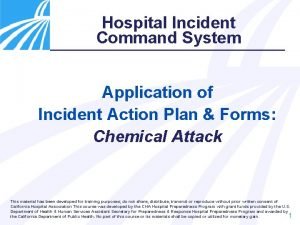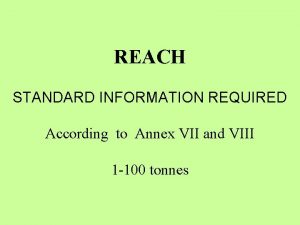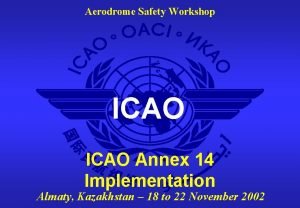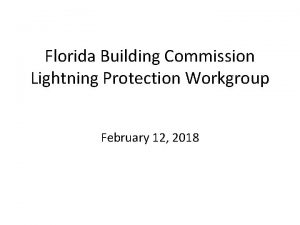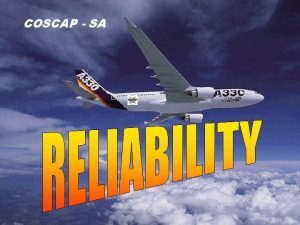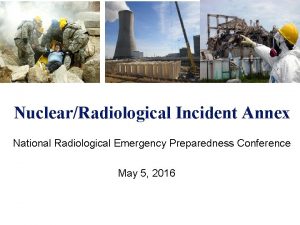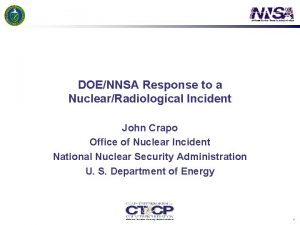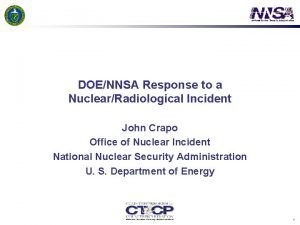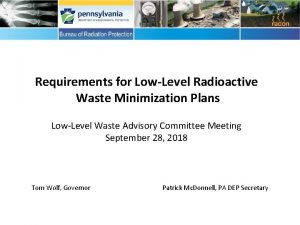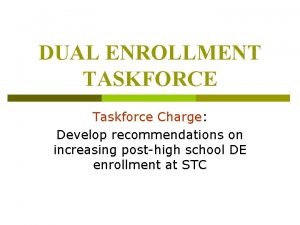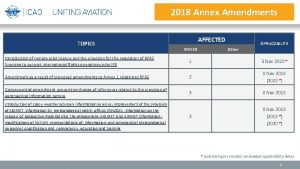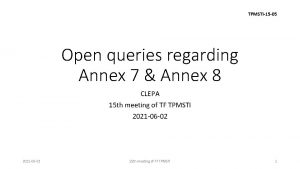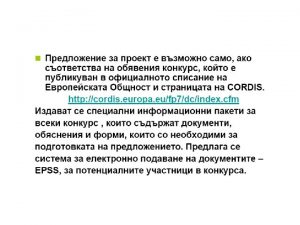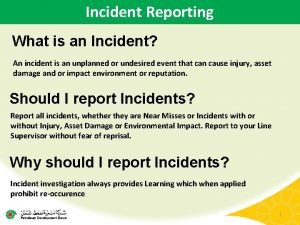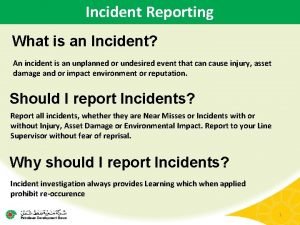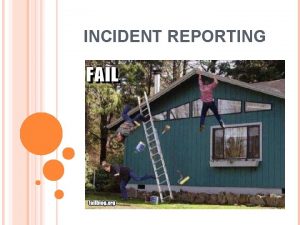NuclearRadiological Incident Annex Nuclear Radiological Incident Taskforce LowLevel


















- Slides: 18

Nuclear/Radiological Incident Annex Nuclear Radiological Incident Taskforce Low-Level Waste Spring Forum April 2018

NRIA Scope • This iteration of the NRIA supersedes the 2008 version and will serve as an operational annex to the Response and Recovery Federal Interagency Operations Plans (FIOPs). • Addresses both inadvertent/accidental incidents and deliberate attacks: - Improvised Nuclear Device (IND) - Radiological Dispersal Device (RDD) - Radiation Exposure Device (RED) - Fixed nuclear facility incidents (deliberate and inadvertent/accidental) - Lost/found/orphaned radioactive material sources - Transportation incidents - Domestic nuclear weapons accidents - Foreign incidents involving nuclear or radioactive material (deliberate and inadvertent/accidental) 2

NRIA - Composition Nuclear/Radiological Incident Annex Base Annex Deliberate Attacks (Branch 1) Inadvertent Incidents (Branch 2) International Incidents (Branch 3)

KEY ISSUES • How will various incident management roles be integrated/coordinated? • How will interagency partners access the incident area/crime scene? • What protocols, equipment, and expertise are needed to monitor responders’ accumulated radiation dose data? • How can we improve pre-incident preparedness at the Federal level? • How will large-scale radioactive waste be managed? • What is the policy for reimbursing host states that provide sheltering and support services? • How will resource requests be de-conflicted? 4

Base Annex Nuclear/Radiological Incident Annex Base Annex Appendices • Appendix 1 Inventory • Appendix 2 Data and Models to Support Nuclear/Radiological Response and Recovery • Appendix 3 Training to Support Nuclear/Radiological Response and Recovery Incidents Federal Response Capability 5

Base Annex Branch 1: Federal Response to and Recovery from Deliberate Nuclear/Radiological Attacks • Provides scenario-specific supplemental information to the Nuclear/Radiological Incident Annex Base Plan. • Applies to all federal responses to deliberate nuclear/radiological incidents, regardless of size or complexity, unless otherwise noted. • The main focus is on a no-notice surface burst IND detonation with a yield of 10 kilotons. 6

Base Annex Branch 2: Federal Response to and Recovery from Inadvertent Nuclear/Radiological Incidents • Provides scenario-specific supplemental information to the Nuclear/Radiological Incident Annex Base Plan. • While focused on an incident at a nuclear power plant, the branch plan applies to all federal response and recovery efforts as they pertain to the unique circumstances of inadvertent nuclear/radiological incident types and locations. 7

Base Annex Branch 3: Federal Response to International Nuclear/Radiological Incidents • Provides supplemental information regarding overseas events to the Nuclear/Radiological Incident Annex Base Plan. • Applies to all federal response and recovery efforts as they pertain to the unique circumstances of international nuclear/radiological incident types. 8

Executive Decision Points A series of time-phased decision points are outlined for executive leadership with guidance on decision criteria, responsible entities, and other information. Examples include: Public Information and Warning Crisis Standards Of Care Emergency and Permanent Work Involving Contaminated Structures Management and Removal of Debris Long Term Waste Management Decontamination Standards / Clearance Goals Funding and Applicability of the Price Anderson Act Remediation and Cleanup

Nuclear/Radiological Incident Task Force (NRITF) Interagency group that convenes within the NRCC to provide nuclear/radiological incident specific subject matter expertise in support of national level incident planning and whole community core capability delivery. 10

NRITF Role The role of the Task Force is to: • Address specific tasks, objectives or issues, related to a nuclear or radiological incident. • The Task Force does not take the place of any Emergency Support Function (ESF), Recovery Support Function (RSF), program area, or agency. • The NRITF is to recommend answers to executive decision points and/or critical information requirements (CIRs) identified in the NRIA and to address specific issues related to nuclear/radiological response and recovery operations. • The task force is an advisory body. It does not have an operational or oversight capacity.

NRITF Membership RN SMEs

Support to Key Decision-making NRITF members will be asked to provide insight into important details that response personnel need to know to meet mission requirements, (critical information requirements, or CIRs). CIRs are identified at the time of incident based on the scope of the incident and the response. They will include: Incident characterization Evacuation and sheltering Protective actions Health effects Radiation exposure RN impacts on Re-entry/Re-occupation resource allocation Infrastructure impacts

Cross-Collaboration NRITF members will collaborate with: Respective agencies’ RN SME teams (ex. DOE; FRMAC) FEMA personnel N-IMAT Discussions are ongoing with Consequence Management Coordination Unit (CMCU) personnel to put in place accreditation policies and procedures to allow for NRITF members to collaborate with the CMCU during the response. NRITF External Affairs Liaison will coordinate with ESF 15, FEMA Office of External Affairs, federal agencies, Joint Information Center, and NRCC.

Federal Agencies with Primary Authority for Nuclear/Radiological Incidents Primary Authority for Federal Response Incident Type, Facilities, or Materials Involved Nuclear Facilities that are: O w n e d or operated by the D O E Licensed by the N R C or an N R C Agreement State W i t h i n facility b o u n d a r i e s – N R C O u t s i d e facility b o u n d a r i e s - F E M A d) Not licensed, owned, or operated by a federal agency, a n N R C Agreement State, or currently or f o r m e r l y l i c e n s e d facilities for w h i c h t h e o w n e r / o p e r a t o r is n o t financially viable or is o t h e r w i s e u n a b l e to r e s p o n d Nuclear W e a p o n s and C o m p o n e n t s that are: e) In the custody of the D O D f) In the custody of the D O E Radioactive Materials Being Transported: g) B y or for the D O D h) B y or for the D O E i) Containing N R C or N R C Agreement State licensed materials j) Within certain areas of the coastal z o n e that are not licensed or o w n e d by a federal agency or an N R C Agreement State k) All others Radioactive Materials in Space Vehicles Impacting the United States that are: l) Managed by the National Aeronautics and Space Administration (NASA) m) Managed by the D O D n) Not m a n a g e d by the D O D or the N A S A a n d impacting certain areas of the coastal zone o) All others Disused and Unwanted Sealed Sources with no Disposition Pathway p) Off-Site Source Recovery U n k n o w n or Unlicensed Materials, and Domestic R e s p o n s e to Foreign Materials and International Incidents: q) Certain areas of the coastal z o n e r) Certain areas outside of the coastal zone s) Imported contaminated c o n s u m e r products that are distributed before detection t) Inadvertently imported radioactive materials a) b) c) u) a b c d ) ) All deliberate attacks involving nuclear/radiological facilities or materials (e. g. , R D D s , INDs) O D O E R C PA e ) f) D O D D O E g ) h) i) j) D D N U k) EPA l) m ) n) o) N D U E p) D O E q) r) s) t) u) U S C G EPA U. S. Customs and Border Protection (CBP) EPA v) DOS/USAID All others U. S. Assistance to Foreign Governments for Incidents with International Impacts v) U. S. G o v e r n m e n t assistance to foreign g o v e r n m e n t r e s p o n s e a n d recovery efforts D D N E O D O E R C S C G ASA O D S C G PA D H S L a w Enforcement a n d Counterterrorism Operations Related to the Incidents in this Table: It i s t h e p o l i c y o f t h e U n i t e d S t a t e s t h a t u n t i l o t h e r w i s e d e t e r m i n e d b y t h e A t t o r n e y G e n e r a l , g e n e r a l l y a c t i n g t h r o u g h t h e F B I Director, a n y w e a p o n s of m a s s destruction incident will b e treated a s a n actual terrorist incident. Note: D H S / F E M A m a y be called u p o n to lead or provide supplemental operational coordination support for the primary authority during complex incidents. 15

Coordination with Interagency Teams 16

Inform Key Decision Points* Public Information and Warning. What is the appropriate public messaging based on the incident type? Personal Protective Equipment Medical Countermeasures What areas have safe exposure limits for first responders to maximize lifesaving operations? Decon Capability, Decontamination Standards / Clearance Goals Infrastructure Decontamination Long-Term Waste Management

 Task force hip hop group
Task force hip hop group Center for devices and radiological health
Center for devices and radiological health National radiological emergency preparedness conference
National radiological emergency preparedness conference Radiological dispersal device
Radiological dispersal device Tennessee division of radiological health
Tennessee division of radiological health Lesson 15 nuclear quest nuclear reactions
Lesson 15 nuclear quest nuclear reactions Fisión nuclear vs fision nuclear
Fisión nuclear vs fision nuclear Unscrea
Unscrea Incident objectives that drive incident operations
Incident objectives that drive incident operations Annex table of contents
Annex table of contents Unfccc annex 1 countries
Unfccc annex 1 countries ıcao annex 1
ıcao annex 1 Marpol annex 1 to 6
Marpol annex 1 to 6 Reach annex vii testing
Reach annex vii testing Meghan biernacki
Meghan biernacki Icao annex 14 summary
Icao annex 14 summary Nfpa 780 annex l
Nfpa 780 annex l 創用cc
創用cc Nn
Nn








